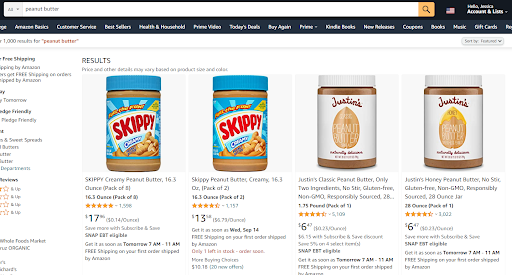Search engines have changed our behavior as shoppers.
We live in a world where many reach for their phones first and drive to the store second. Around 81% of purchases begin with an Internet search.
And the majority of users will start that journey on one of two sites: Amazon and Google.
As an e-commerce business owner, these platforms are where you need to meet your customers.
Yet with countless other competitors vying for the same spots on the front page of search results, how do you push your way to the top?
Here’s where search engine optimization (SEO) comes in.
SEO has become a central piece in global brands’ and small businesses’ marketing strategies.
But what some sellers might not know is that rules change when you move between Amazon and Google.
What works for one is wasted effort for the other.
My name is Omar Deryan, CEO at OJDS. I have worked with over 3000 e-commerce sellers over the past 5 years.
And in this article, we’ll take a peek under the hood and find out what makes Amazon and Google’s search algorithms tick so you leverage their power to get more leads and sales for your e-commerce business.
Let’s get started.
How Does Amazon SEO Work?
Amazon SEO ranking factors revolve around two things:
- Ensuring the best customer experience
- Optimizing for sales conversions
At the end of the day, Amazon makes money by taking a cut of the seller’s revenue. The more people buy, the more Amazon makes money.
Its top priority is to get customers to buy and keep them coming back.
That means crafting a seamless shopping experience, from how you navigate the listings to the quality of after-sales customer service.
How Does Google SEO Work?
Google is the most widely used search engine on Earth. The term Google itself has become synonymous with discovery. Need a question answered? Just Google it!
Google’s search engine algorithm is nothing short of incredible.
After you submit a query, it crawls the entirety of the Internet–all 5 million terabytes of it–and returns with an answer in mere seconds.
To do that, it relies on a set of signals that tell it how relevant a page is to your question.
These factors primarily revolve around one thing: relevance.
And so, Google SEO focuses on establishing relevance through keywords, publishing updated content, and link building, among other methods.
Amazon vs Google: Key Differences
1. Purpose
One of the biggest differences between Amazon and Google is the intent behind the search.
Users on Amazon have a very specific intention: to shop.
Everything revolves around it. You’re either window shopping, looking for cheaper deals, or checking product reviews.
In contrast, a user can be googling for an endless number of reasons.

Asking what users search for on Google is akin to asking what they’re doing on the Internet–anything and everything.
This fundamental difference between Google and Amazon is key to understanding how the search engines on both platforms work.
2. Algorithm
An algorithm is the core of any search engine.
Think of it as the brain of the platform.
Algorithms determine which signals search engines pay attention to and how much weight to put behind every factor.
Now, because Google and Amazon serve different purposes, their algorithms will be scoring things differently.
Amazon designed the Amazon A10 algorithm around customer satisfaction.
That means giving them the right product at premium quality.
You wouldn’t be very happy if your search for aromatherapy oils returned with listings for cooking oil or recommended a product with bad reviews.
To match products as closely as possible to the buyer’s search intent, Amazon looks at several things.
Like Google, it evaluates if you’re writing for a person rather than a search engine. It also looks at Exit Rate, which is similar to Google’s Bounce Rate.
But that’s where most similarities end.
Because Amazon is an online store, its algorithm looks at factors Google never will, such as Sales velocity, Return Rates, and Late Shipment Rates.
On the other hand, Google uses on-page elements you won’t find on Amazon, like Header Tags and Image Tags.
These guide Google’s crawlers through your website, helping match content with search intent.
3. Linking
This one’s easy.
On Amazon, you’re not allowed to use links in your listing.
So you can’t direct shoppers to your website. It’s only if you are brand registered and have the A+ content feature set up that you can link to other listings you own within Amazon.
Also, building links to your amazon listing won’t impact your ranking.
On Google, link building is integral for raising your ranking. Inbound linking is one of its oldest metrics, used way back when it was still known as BackRub.
Today, inbound links are still vital for establishing authority. Internal linking is a way to keep visitors on your site longer.
4. Complexity
Data analysis is integral to developing SEO strategies, no matter which platform you’re on.
But on Google, the volume is denser than most. Complexity is a problem faced even by expert marketers.
That’s why there are so many tools to help you make sense of the data, from the company’s own Google Analytics to third-party dashboards like Ahrefs.
Amazon SEO is relatively simpler compared to Google.
You don’t have to bother with tweaking sitemaps or optimizing load times–that’s Amazon’s job.
You only have to focus on one thing: selling.
Amazon seller tools can help you find competitive keywords and products.
Amazon vs Google: Similarities
1. Unparalleled Reach And Popularity
When it comes to the number of users, few equal Amazon. And no one comes close to Google.
There are 4.72 billion people who use the Internet. Of those, 4.3 billion use Google to navigate all the world’s data.
Meanwhile, Amazon opens its digital doors to billions of shoppers each year. Around 2.2 billion people visit the site, making it the largest ecommerce store outside of China.
So when it comes to marketing and selling your products, there are no larger platforms than Google and Amazon.
2. Constant Testing Is The Name Of The Game
When it comes to ranking on search engines, you don’t keep the number one spot unless you work for it. Constantly.
Both Amazon and Google place a lot of importance on up-to-date information. Consumer needs are constantly shifting, and so are what gains clicks and conversions.
An organic SEO strategy that worked the previous month may not the next time Amazon or Google rolls out an update. Ads with high Click Through Rates (CTR) can be outbid or become outdated.
So search engine optimization is always an evolving process. You’ll need to stay on top of it by monitoring your traffic and frequent A/B testing in search of optimal settings.
3. Both Utilize Organic And Paid Search
Anyone who has ever used Google is familiar with the ads that pop up on top of a search engine results page (SERP).
These are Dynamic Search Ads (DSA) and are one of the many ad placements you can bid for on Google.
Paid ads aren’t the only way to reach the top spot.
Below DSAs, you’ll find pages upon pages of organic search results. These are links that have ranked using optimization best practices instead of paid marketing.
You’ll find a similar landscape on Amazon.

Paid ads appear on different parts of the site. Sponsored Ads crowd the top of the SERPs, and organic results follow.
4. User Satisfaction At Its Core
Gone are the days when spamming keywords worked, and barely comprehensible copy littered the Internet.
Over the years, Amazon and Google have tweaked their algorithms to become more intelligent, distinguishing valuable content from filler junk.
Amazon even goes beyond your amazon listing when evaluating your SEO score because the customer experience doesn’t stop at the Buy Box.
Bad reviews can bring down your discoverability, even if you optimize your copy from top to bottom.
Google looks at signals such as time spent on site and bounce rate to determine if a customer is happy with a search result.
All these boil down to one thing: User satisfaction is king, whether you’re on Google or Amazon.
The 2 Main Principles To Optimize for Amazon And Google
Now that we’ve gone through Google and Amazon’s similarities and differences, you might be wondering if there are best practices that apply to both platforms.
The answer is yes.
While your Google SEO and Amazon SEO efforts will definitely look different, there are two things you can remember that will help you succeed in both.
Keyword Research
Keywords will be at the center of any SEO strategy, no matter which platform you’re on. Your traffic volume, SERP ranking, and conversions will hinge on choosing keywords that are relevant to your audience.
Focus On User Experience
When in doubt, remember the user. Getting all the technical SEO aspects down perfectly matters little if your copy is poorly written, your article doesn’t answer the query, or if your product fails to deliver as advertised.
Google SEO Best Practices
As an e-commerce seller, in the end, your goal is to get leads to your product.
And to get leads to your products, you need to rank on google for the keywords your ideal client is looking for.
On page SEO
Create a list of keywords related to your product and integrate these keywords into your product title, product description, meta description, and slug.
You can check this article for a more in-depth tutorial.
Relationship and link building
As mentioned before, backlinks and domain authority are key Google ranking factors.
However, it can be hard to get other sites to link to your product pages.
The solution?
Creating a linkable asset.
A linkable asset is a page other sites want to link to. It can be an ultimate guide, a calculator, an infographic, or a study.
It can be related to your industry or even a related industry.
How to choose your linkable asset?
Use a backlink analysis tool to find what articles in your industry (or related industry) get the most links.
You can check the backlink profiles of your top competitors or a well-known information site.
Analyze which pages are getting the most backlinks.
Create a better page.
Reach out to the sites that linked to their asset to link to yours.
The next step is to add a link to your product page in your linkable asset.
The linkable asset will pass the authority to your product page and help it rank higher on Google.
Amazon SEO Best Practices
One of the key Amazon ranking factors is sales velocity.
For example, If you type “peanut butter” on the Amazon search bar, the products that appear on the first page are the ones that make the most sales (and more money for Amazon)

If a listing is making money, that means:
- It is being found: You can’t make sales if no one can find your product. That’s why keyword research and adding the right keywords in your product listing go a long way in boosting your visibility and ranking on the platform. Also, you can also promote your listing via PPC campaigns, influencer marketing, and social media ads.
- It has a high conversion rate: This is crucial, especially for first-time buyers. A high conversion rate on Amazon depends on many factors, including your images, title, product copy, price, and reviews.
- High client satisfaction: Customers like the product and keep coming back for more. For that, you need to have a high-quality product that offers excellent value for the price.
By optimizing for these 3 criteria, you will get more sales, and by getting more sales, you will rank higher.
If you are just starting out and are suffering from the chicken and egg dilemma, a proper amazon product launch will help you get the ball rolling.
Amazon SEO vs Google SEO: The Verdict
Amazon and Google’s search engines probably see the most traffic out of any other search engines on the planet. These two are inextricably woven into how we navigate the Internet itself.
But while search drives both platforms, they fundamentally differ in how they lead us to what we’re looking for.
Amazon’s top priority is recommending the right product, while Google wants to answer questions the best way possible.
This difference will change your SEO approach, as you’ll need to optimize unique metrics and elements not found in the other.
What’s important is never losing sight of the human at the other end of the search bar.
Amazon and Google may be using different algorithms, but their end goal is the same: improving the customer experience.
If you can align your SEO efforts with that, search engines will have no choice but to take notice.

